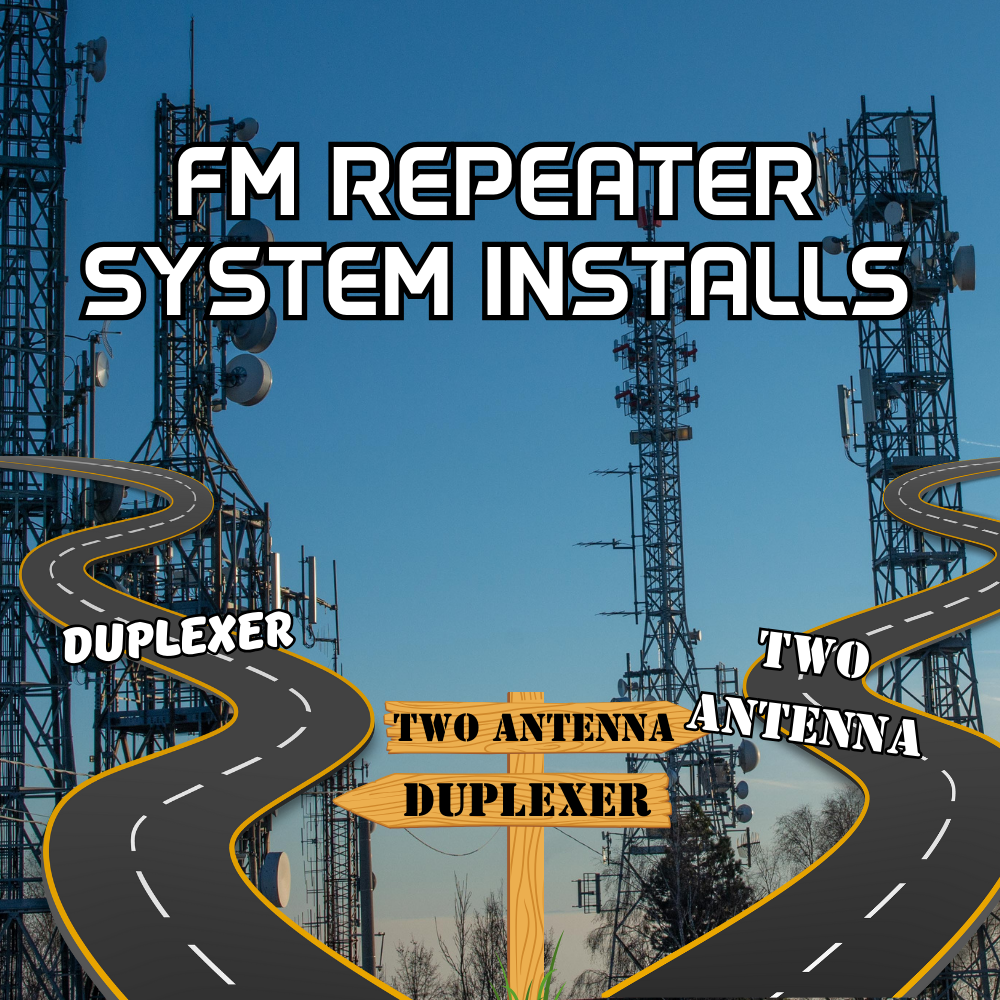
FM Repeater System Installations: Duplexer vs. Two Antennas
FM Repeater System Installations: Duplexer vs. Two Antennas
Introduction:
FM repeaters play a crucial role in extending the communication range and effectiveness of radio operators. When it comes to setting up FM repeater systems, one important consideration is the choice between using a duplexer or two separate antennas. In this article, we will explore the pros and cons of both approaches and delve into the details of two separate antenna arrays: stacked vertical and spatial diversity. Additionally, we will discuss how to calculate the optimal separation distance for each arrangement in VHF and UHF.
Pick up your own FM Radio Repeater in our Latest Repeater Sale! Make sure you know what you want by following Along and Grabbing a Repeater here! www.bridgecomsystems.com/pages/repeater-sale-2024
I. Duplexer:
A duplexer is a specialized device that allows for the sharing of a single antenna between the transmitter and receiver. Here are the advantages and disadvantages of using a duplexer in an FM repeater system:
Pros:
Space and Cost Efficiency: By using a single antenna and feedline, a duplexer helps minimize the hardware required, reducing installation costs and saving valuable space.
Simplicity: With a duplexer, there is no need to install and align separate transmit and receive antennas, streamlining the installation process.
Improved Isolation: A properly tuned and high-quality duplexer can provide excellent isolation between the transmitter and receiver frequencies, reducing interference and maximizing system performance.
Cons:
Limited Frequency Separation: Duplexers have a specific frequency separation range they can handle effectively. If the transmit and receive frequencies are too far apart, a more complex and expensive duplexer might be required.
Complexity in Tuning: Duplexers often require precise tuning to achieve optimal performance, which may require technical expertise or professional assistance.
Potential Losses: Duplexers can introduce insertion loss, resulting in a slight decrease in overall system gain.
II. Two Antennas:
Using two separate antennas, one for transmit and one for receive, is an alternative approach for FM repeater installations that don't use a duplexer. Let's explore the advantages and disadvantages of this method:
Pros:
Greater Flexibility: With two separate antennas, you have more control over antenna placement, allowing for optimal positioning to enhance coverage and reduce interference.
Improved Isolation: Using separate antennas inherently provides physical separation between the transmit and receive signals, minimizing the risk of interference.
Enhanced Performance: By using high-gain antennas specifically designed for either transmit or receive, you can potentially achieve better signal quality and extended coverage.
Cons:
Increased Hardware and Cost: Utilizing two antennas requires additional hardware, such as mounts, feedlines, and connectors, resulting in higher installation costs.
Space Constraints: Installing two separate antennas may be challenging in situations where space is limited, such as on small towers or rooftops.
Alignment and Maintenance: Aligning two antennas for optimal performance requires careful adjustment, and regular maintenance may be needed to ensure continued performance.
III. Two Separate Antenna Arrays:
Digging deeper into using two antennas, the following configurations are possible, Stacked Vertical Array and Spatial Diversity Array.
Stacked Vertical Array:
In the Stacked Vertical Array configuration, the transmit (TX) antenna is placed on top, while the receive (RX) antenna is positioned below it. The separation distance between the antennas depends on the frequency band of operation. Here's how to calculate the best separation distance for each tech band:
a. VHF or 2m Band:
The wavelength at the center frequency of the 2m band (144-174 MHz) is approximately 2.05 meters. As a general guideline, a vertical spacing of around half a wavelength is recommended. Therefore, an initial estimate for the separation distance would be approximately 1.02 meters or 102 centimeters.
b. VHF or 1.25m Band:
The wavelength at the center frequency of the 1.25m band (220 MHz) is approximately 1.25 meters. A vertical spacing of around half a wavelength is advised, resulting in an estimated separation distance of approximately 0.68 meters or 68 centimeters.
c. UHF or 70cm Band:
The wavelength at the center frequency of the 70cm band (420-470 MHz) is approximately 0.69 meters. As a general guideline, aim for a vertical spacing of around half a wavelength, which would yield an approximate separation distance of 0.34 meters or 34 centimeters.
Spatial Diversity Array:
In this configuration, the two antennas are horizontally spaced apart while being at the same height. The optimal spacing depends on factors such as antenna characteristics, radiation pattern, and desired coverage goals. On-site measurements, simulations, or expert consultation can assist in fine-tuning the spacing for each tech band.
Conclusion:
When considering FM repeater system installations, the choice between using a duplexer or two separate antennas involves trade-offs in simplicity, cost, and performance. Duplexers offer space efficiency and ease of installation, while two antennas provide flexibility and improved isolation. In the Stacked Vertical Array configuration, placing the TX antenna on top and the RX antenna below ensures minimized interference and optimal performance. Calculating the optimal separation distances for each arrangement in the 2m, 1.25m, and 70cm tech bands is crucial for achieving optimal system performance.
Ultimately, the choice should be based on the specific requirements, constraints, and objectives of your FM repeater installation in ham radio. Consider factors such as frequency separation, available space, budget, and desired coverage goals. Consulting with RF engineering professionals or experienced ham radio operators can provide valuable insights and guidance tailored to your unique situation.
Pick up your own FM Radio Repeater in our Latest Repeater Sale! Make sure you know what you want by following Along and Grabbing a Repeater here! www.bridgecomsystems.com/pages/repeater-sale-2024
(Note: The article provides general information about FM repeater installations. It is recommended to consult with RF engineering professionals for specific advice tailored to your unique situation.)
If you have any further questions or need additional information, please comment below!







1 comment
Always great Educational Articles, Thank you to all that research and prepare them.